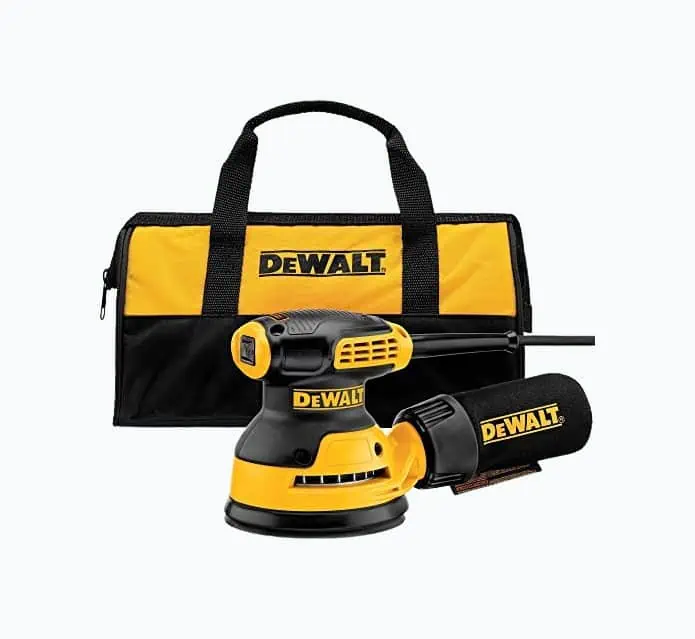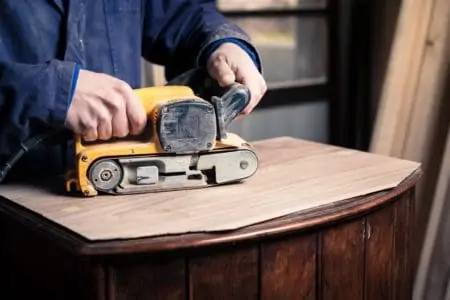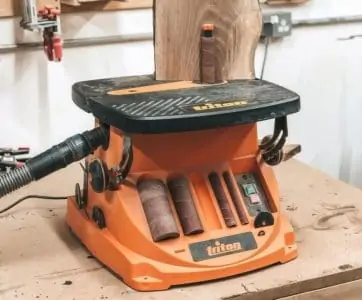Refinishing furniture requires the right tools. Whether you are a pro or an amateur, getting the right sander is crucial if you want the best results.
So, how do you ensure you have the best tool for the job?
You’re in luck because we review the best sanders for refinishing furniture to bring you our top five.

- 3-Amp motor
- Random sander
- Locking dust port

- Maximum of 11,000 OPM
- Two additional speed settings
- Fast charging

- Efficient material removal
- Oversized sealed ball bearing
- Rubberized grip

- Multiple tools in one
- Plenty of accessories
- 3-speed selector

- 3-way grip
- Finger detail attachments
- 14,000 OPM
Review Methodology: At Sensible Digs, we understand the importance of reliable and informative evaluations. Our examination of the best sanders for refinishing furniture is rooted in hands-on testing and professional assessments. Backed by data and firsthand experience, we compare and rank sanders based on key decision-making factors like performance, design, and ease of use. Our reviews offer clear, objective analysis, helping you discern what sets each product apart. We measure and track important criteria such as power, dust collection, and comfort, providing you with the facts you need to make an informed decision. Trust our expertise and our commitment to providing you with the most accurate, relevant information.
- Our Top Picks
- Product Reviews & Ratings
- Product Comparison Chart
- Should I Sand or Strip Furniture?
- Types of Sanders for Refinishing Furniture
- How To Choose the Best Sander for Refinishing Furniture
- Tips on Using a Sander for Refinishing Furniture
- Sanders for Refinishing Furniture FAQs
- Best Sander for the Job
The Best Sanders for Refinishing Furniture of 2024
Here are our favorite sanders for refinishing furniture.
DeWALT DWE6421K Random Orbit Sander
Best Orbital Sander for Refinishing Furniture
Random orbital sanders work slightly differently to orbit sanders. Rather than just spinning on a fixed axis, a random sander has an off-center axis, allowing the sanding pad to rotate and move side to side at the same time.
It has a 3-amp motor that generates 12,000 OPM and a dust-sealed switch to stop sawdust causing damage. The dust collection comes courtesy of a bag or direct connection to a central vacuum system.
The rubber overmold increases comfort, and the counterbalance reduces vibration for the most comfortable user experience.
What We Like
Quality Brand
DeWALT is a global concern, famed the world over for reliability and quality. It’s the reason why you find DeWALT products in the hands of professionals and amateurs alike.
Random Motion
Unlike orbit sanders, random models spin on an off-center axis to create a random motion of spinning and sideways movement. It’s the most efficient way of removing material.
Locking Dust Port
The dust port locks using one hand, making it easy to secure the collection bag or central vacuum hose.
What We Don't Like
Limited Uses
While a random orbital sander is a great multi-use tool, it has its limitations. You will struggle to get detailed finishing with this tool, and it isn’t the best to use on intricate edges and furniture.
Product Specs
| Weight (pounds) | 4 |
| Dimensions (inches) | 10.38 x 7.25 x 6.18 |
| OPM | 12,000 |
| Amps | 3 |
| Accessories | Carry bag |
| Price | $$ |
| Warranty | 3-year limited |
Our Ratings
User Experience
Makita XOB01Z 18V Cordless Sander
Best Cordless Sander for Refinishing Furniture
Going cordless is a great way to liberate yourself from power cords and electrical supplies. It means you can take this tool anywhere. The power comes from a lithium-ion battery (not included), and it generates a maximum of 11,000 OPM.
You also get 40 minutes of continuous use at the low-speed setting and 20 minutes on full speed between charges. Also, the advanced technology gives you 50 percent more runtime and three times faster charging.
It also has two other speed settings ranging from 7,000 to 9,500 OPM. Like the DeWALT, it has a random action for efficient material removal, and it benefits from an ergonomic handle that increases comfort while reducing fatigue.
What We Like
Cordless Is King
Throw off the shackles of power cords forever and go cordless. You can take this tool anywhere to work. It also increases your maneuverability because you are not restricted by the cord, allowing you to get into the tightest spots.
Random Motion
Remove more material with this random sander. Rotating on an off-center axis increases the efficiency of the sander, speeding up material removal.
Fast Charging
The downside to a cordless power tool is waiting for it to recharge. This Makita deals with the problem by increasing the speed it charges by 3 times that of the competition.
What We Don't Like
You Need a Spare Battery
For this sander to work effectively, you should consider buying two batteries so that you always have a spare when the power starts to drain.
No Battery Included
Selling a battery-operated sander without the battery or charger means that you have to factor in the additional financial burden. This makes an expensive sander even more costly.
Product Specs
| Weight (pounds) | 2.9 |
| Dimensions (inches) | 5.16 x 8.07 x 6.89 |
| Max OPM | 11,000 |
| Amps | 18 volts (Cordless tools are rated in voltage) |
| Accessories | N/A |
| Price | $$$ |
| Warranty | 3-year limited |
Our Ratings
Personal Perspective
Makita BO5030K 5-Inch Random Orbit Sander
Best Sander for Table Tops
When you are sanding tabletops, you need a tool that works best on flat surfaces. This Makita random orbital sander removes more material while minimizing swirl marks, thanks to the way it oscillates. A pad control system decreases surface marks for the smoothest finish.
It has a 3-amp motor, producing 12,000 OPM, and a rubberized grip for better control and comfort. It also has low-vibration, which further reduces hand fatigue. Makita has also fitted this sander with an oversized sealed ball bearing for longer tool life.
The dust-sealed power switch stops dust from entering the device, and it is conveniently located for easier control.
What We Like
Efficient Material Removal
Tables are flat, which is the ideal environment for this random orbital sander. It efficiently removes material with less effort and fewer swirl marks. It all adds up to a perfectly finished tabletop.
Oversized Sealed Ball Bearing
Makita is famed for the quality of its products, and this model is no exception. It has an oversized sealed ball bearing to increase the tool’s working life.
Rubberized Grip
The rubberized grip increases the comfort factor while decreasing hand fatigue. Ergonomics plays a major role in power tool usability, providing the best user experience possible.
What We Don't Like
Limited Uses
For all its strengths in sanding flat surfaces, this model is limited when refinishing intricate shapes and edges. You would get more satisfaction from a detail sander.
Product Specs
| Weight (pounds) | 2.87 |
| Dimensions (inches) | 15 x 7 x 10 |
| Max OPM | 12,000 |
| Amps | 3 |
| Accessories | Carry case and dust bag |
| Price | $$ |
| Warranty | 1-year limited |
Our Ratings
Community Feedback
DeWALT 20V MAX XR Oscillating Multi-Tool
Best Multi-Tool Sander for Refinishing Furniture
It’s pretty hard to beat a multi-tool for all-around performance. When finishing furniture or restoring something from scratch, having the ability to interchange different sanders and tools within one kit is invaluable.
This DeWALT has a 3-speed selector to adjust the rate of the tool to cater to different materials. Plus, it has a variable speed trigger for more responsive applications. This cordless model has a brushless motor, which delivers 57 percent more battery runtime.
It also has an LED light and tool-less head changes for speed and convenience.
What We Like
Multiple Tools in One
What could be better than a tool that cuts, grinds, shaves, and sands? When restoring or finishing furniture, versatility is the key to a better outcome. This tool gives you that option.
Plenty of Accessories
Unlike some models, this kit is generous. It comes with different heads and a battery, charger, and spare sanding pads. It really is the complete set to get you started straight out of the box.
Cordless Freedom
The lithium-ion battery delivers efficient power to perform at the peak for longer. You can buy larger capacity batteries to keep you working for longer. It also comes with a charger, unlike the Makita cordless model.
What We Don't Like
Requires Spare Battery
Ask anyone with a cordless power tool, and they’ll tell you that you need a spare battery to work effectively. It means you always have a fully charged battery while the other drains.
Very Expensive
To get this kit, you will need deep pockets. It costs over 7 times the price of the budget model, so it is more likely to appeal to a professional or experienced woodworker.
Product Specs
| Weight (pounds) | 2.33 |
| Dimensions (inches) | 17.15 x 5.03 x 9.65 |
| Max OPM | Not stated |
| Amps | 20 volts (Cordless tools are rated in voltage) |
| Accessories | Different attachments, spare pads, and a carry bag |
| Price | $$$$$ |
| Warranty | 3-year limited |
Our Ratings
First-Hand Impression
Black and Decker Mouse Detail Sander
Best Detail Sander for Refinishing Furniture
This mouse detail sander is worthy of your attention, and not just for the price. It has a 3-position grip for better control and comfort, along with a compact and lightweight design to reduce hand and wrist stress.
For super-detailed finishing, a finger detail attachment comes in handy, and a highly effective dust collection keeps you safe from harm. But what about that price? Well, you could own this detail sander for less than one-sixth of the cost of the DeWALT multi-tool.
The 1.2-amp motor generates 14,000 OPM, and while it isn’t the most powerful detail sander, it is adequate for most furniture finishing tasks.
What We Like
Unbelievably Affordable
If you have a limited budget or you are new to the world of furniture finishing, this Black and Decker tool is the best way to get started. Sure, you will need to graduate to better sanders in time, but at this price, it’s almost irresistible.
3-Way Grip
You get 3 options when you grip this sander. You can use the handle, place your thumb on the side for stability, or hold it from the top using the palm grip. However you grip it, you cannot deny it gives you better control.
Finger Attachments
This is a detail sander, but when you want extra-fine sanding, a finger attachment is a useful tool. It adds to your versatility, giving you the ability to reach previously unreachable spots.
What We Don't Like
Cheap Quality
We can wax lyrical all day about how cheap this sander is, but you can tell when you look at the quality of the components. It feels cheaply made because it is. You get what you pay for.
Product Specs
| Weight (pounds) | 2.4 |
| Dimensions (inches) | 10.25 x 4.63 x 5.44 |
| Max OPM | 14,000 |
| Amps | 1.2 |
| Accessories | Finger attachment, plus spare pads |
| Price | $ |
| Warranty | 2-year limited |
Our Ratings
User Experience
| Product | Best | Weight | Dimensions | OPM | Amp/Volt | Warranty |
|---|---|---|---|---|---|---|
| DeWALT Random Orbit Sander | Orbital Sander | 4 lbs | 10.38 x 7.25 x 6.18″ | 12,000 | 3 Amp | 3-year limited |
| Makita 18V Cordless Sander | Cordless Sander | 3 lbs | 5.16 x 8.07 x 6.89″ | 11,000 | 18V | 3-year limited |
| Makita Random Orbit Sander | Table Tops | 3 lbs | 15 x 7 x 10″ | 12,000 | 3 Amp | 1-year limited |
| DeWALT 20V Oscillating Multi-Tool | Multi-Tool | 2 lbs | 17.15 x 5.03 x 9.65″ | N/A | 20V | 3-year limited |
| Black + Decker Mouse Detail Sander | Detail Sander | 2 lbs | 10.25 x 4.63 x 5.44″ | 14,000 | 1.2 Amp | 2-year limited |
Should I Sand or Strip Furniture?
In the main, it’s better to strip furniture than to sand. Stripping involves less work than sanding, especially if the old surface is flaking off. A paint and varnish remover makes light work of removing several layers at a time.
Often, when refurbishing old furniture, you need to remove years of paint and varnish, some of it lead-based. A paint stripper is the safest way to scrape away these layers without harmful dust lingering in the air.
Sanding is better when you have surface damage or thin layers of paint that strip away easily. Once you have stripped your furniture back to the original wood, you can begin sanding to get the smoothest results.
Types of Sanders for Refinishing Furniture
There are so many choices when it comes to the right sander for your furniture. Let’s take a look at your options.
Detail Sander
As the name suggests, a detail sander is the best tool for detail finishing. This is thanks to its triangular-shaped sanding pad that allows the user to get into tight corners and edges. If you are restoring an ornate cabinet or your furniture has awkward edges and curves, a detail sander is the best tool.
Just remember, details sanders are compact, and are not as efficient as orbital sanders at removing material. So, if you are refinishing a table, a larger sander might be a better option.
Orbital Sander
Orbital sanders are the mainstay of any woodworker tool kit. They can multitask with the best of them. However, they might not be your best option for furniture restoration because of the circular sanding pad.
It restricts you to sanding flat surfaces only and not intricate curves and corners. That’s where the detail sander has the advantage over the orbit sander. Again, for flat surfaces, an orbit sander will remove old paint and varnish easily, and because the pad rotates, you can work in any direction.
Palm Sander/Finishing Sander
This is the best of both worlds because a palm or finishing sander is a mix of an orbital and detail sander. Thanks to the compact design and ability to remove material, there are more advantages than disadvantages.
Most palm sanders have a square or rectangular pad, so they can reach edges and corners with ease, and thanks to the orbital motion, you can still remove a decent amount of material. If we had to pick between the three, the palm/finishing sander is the best choice for versatility and all-around ability.
How To Choose the Best Sander for Refinishing Furniture
So, you need to choose the best sander for furniture refinishing. What are the details you need to consider to get the best tool? Let’s take a look.
Tips on Using a Sander for Refinishing Furniture
Once you decide which sander is right, you need all the help you can get learning how it handles. You could also benefit from hints and tips to get the best results.
It’s All About the Grit
For older, thicker surfaces, use lower grit sandpaper. Try 80 to 100 grit for the best results. Lower-grade sandpaper removes lots more material in one go. If you have substantial blemishes and scratches, the lion’s share of the work is done using low grit paper.
It’s Still All About the Grit
Once you kick-start the restoration with lower grit paper, as you work through the process, scale up the sandpaper by increasing the grit. A good mid-range is around 120 to 150, while finishing requires 220 to 300.
Wear Protection
Wood dust is dangerous. It sits in your lungs, causing all sorts of problems. Personal safety is paramount when sanding old furniture. You should put on an N95 facemask to remove 95 percent of pollutants.
Also, restoring and refinishing furniture might release chemical residue found in lead paint and old varnishes, so protection is vital. Goggles are also required for the same reasons. plus, earplugs or defenders reduce the noise created by the sander.
Apply Light Pressure
Always work slowly and steadily. Too much pressure risks hollowing out even surfaces. It also puts undue strain on the sander. Also, you want to reduce surface marks, so a lighter touch is preferred.
Work With the Grain
Unless you are painting the furniture, work with the grain where possible as it could highlight surface scratches and marks when you apply the stain.
Use a Stocking
If you want to check how smooth the finish is, run a stocking over the surface to see if it snags. If it does, you need to carry on sanding until it is 100 percent blemish-free.
Sanders for Refinishing Furniture FAQs
Best Sander for the Job
Refinishing furniture is a skilled job. It takes know-how and experience, as well as the right tools. And knowing which tools are best for the job is an art in itself. While the sanders we chose all perform the same basic tasks, they are not all equal.
Hopefully, this article clarifies the strengths and weaknesses each sander possesses so that you can make an informed choice.

















